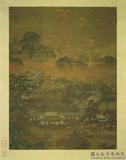元陸廣五瑞圖 軸
推薦分享
資源連結
連結到原始資料 (您即將開啟新視窗離開本站)後設資料
- 資料識別:
- 故畫000317N000000000
- 資料類型:
- 類型:繪畫
- 型式:靜態圖像
- 著作者:
- 陸廣
- 主題與關鍵字:
- 奇石 萱花 竹 靈芝 椿 蘭.蕙
- 出版者:
- 數位化執行單位:國立故宮博物院
- 格式:
- 本幅 126.1x60.6公分、全幅 70.5公分
- 關聯:
- 石渠寶笈三編(延春閣),第四冊,頁1646&*故宮書畫錄(卷五),第三冊,頁238&*故宮書畫圖錄,第五冊,頁67-68&*陸廣(活動於西元十四世紀中期),江蘇吳縣人。字季弘,號天游生。善山水,彷王叔明,落筆蒼古,用墨不凡。 本幅畫芝、蘭、萱草、朱竹、大樁,足以坡石。芝蘭芳草喻人家佳子弟,大樁長年,萱草忘憂,竹報平安,故名之日五瑞。&*Lu Kuang (style name Chi-hung; sobriquet Tien-yu-sheng) was a native of Wu County, Kiangsu. He excelled at painting landscapes, imitating the works of Wang Meng (1308-1385). His brushwork has an archaic quality and his use of ink is extraordinary. This painting depicts "ling-chih" (a species of fungus), orchids, iris, bamboo, and a '1ong-1ife’ tree growing on a slope near a fantastic rock. The "ling-chih" and orchids are inconspicuously rendered,as are the fragrant grasses. These three kinds of plants are commonly used to symbolize the principles of fraternal love and filial piety. The 'long-life' tree symbolizes longevity, of course; the iris, optimism; and the bamboo, peace. Thus, the painting is entitiled "Five Auspicious Symbols."
- 管理權:
- 國立故宮博物院
授權聯絡窗口
- 國立故宮博物院圖像授權、出版授權、影音資料授權-申請流程說明
http://www.npm.gov.tw/zh-TW/Article.aspx?sNo=03003061






